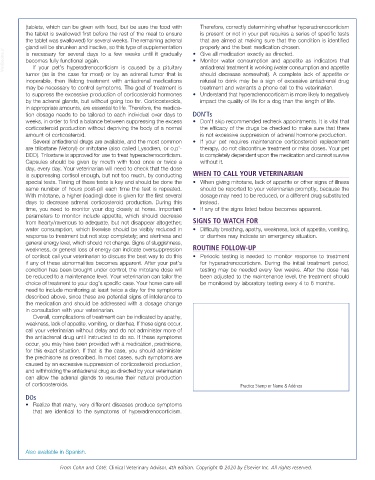Page 3031 - Cote clinical veterinary advisor dogs and cats 4th
P. 3031
(tablets, which can be given with food, but be sure the food with Therefore, correctly determining whether hyperadrenocorticism
the tablet is swallowed first before the rest of the meal to ensure is present or not in your pet requires a series of specific tests
the tablet was swallowed) for several weeks. The remaining adrenal that are aimed at making sure that the condition is identified
properly and the best medication chosen.
gland will be shrunken and inactive, so this type of supplementation • Give all medication exactly as directed.
VetBooks.ir becomes fully functional again. • Monitor water consumption and appetite as indicators that
is necessary for several days to a few weeks until it gradually
antiadrenal treatment is working (water consumption and appetite
If your pet’s hyperadrenocorticism is caused by a pituitary
tumor (as is the case for most) or by an adrenal tumor that is should decrease somewhat). A complete lack of appetite or
inoperable, then lifelong treatment with antiadrenal medications refusal to drink may be a sign of excessive antiadrenal drug
may be necessary to control symptoms. The goal of treatment is treatment and warrants a phone call to the veterinarian.
to suppress the excessive production of corticosteroid hormones • Understand that hyperadrenocorticism is more likely to negatively
by the adrenal glands, but without going too far. Corticosteroids, impact the quality of life for a dog than the length of life.
in appropriate amounts, are essential to life. Therefore, the medica-
tion dosage needs to be tailored to each individual over days to DON’Ts
weeks, in order to find a balance between suppressing the excess • Don’t skip recommended recheck appointments. It is vital that
corticosteroid production without depriving the body of a normal the efficacy of the drugs be checked to make sure that there
amount of corticosteroid. is not excessive suppression of adrenal hormone production.
Several antiadrenal drugs are available, and the most common • If your pet requires maintenance corticosteroid replacement
are trilostane (Vetoryl) or mitotane (also called Lysodren, or o,p’- therapy, do not discontinue treatment or miss doses. Your pet
DDD). Trilostane is approved for use to treat hyperadrenocorticism. is completely dependent upon the medication and cannot survive
Capsules should be given by mouth with food once or twice a without it.
day, every day. Your veterinarian will need to check that the dose
is suppressing cortisol enough, but not too much, by conducting WHEN TO CALL YOUR VETERINARIAN
special tests. Timing of these tests is key and should be done the • When giving mitotane, lack of appetite or other signs of illness
same number of hours post-pill each time the test is repeated. should be reported to your veterinarian promptly, because the
With mitotane, a higher (loading) dose is given for the first several dosage may need to be reduced, or a different drug substituted
days to decrease adrenal corticosteroid production. During this instead.
time, you need to monitor your dog closely at home. Important • If any of the signs listed below becomes apparent.
parameters to monitor include appetite, which should decrease
from hearty/ravenous to adequate, but not disappear altogether; SIGNS TO WATCH FOR
water consumption, which likewise should be visibly reduced in • Difficulty breathing, apathy, weakness, lack of appetite, vomiting,
response to treatment but not stop completely; and alertness and or diarrhea may indicate an emergency situation.
general energy level, which should not change. Signs of sluggishness,
weakness, or general loss of energy can indicate oversuppression ROUTINE FOLLOW-UP
of cortisol; call your veterinarian to discuss the best way to do this • Periodic testing is needed to monitor response to treatment
if any of these abnormalities becomes apparent. After your pet’s for hyperadrenocorticism. During the initial treatment period,
condition has been brought under control, the mitotane dose will testing may be needed every few weeks. After the dose has
be reduced to a maintenance level. Your veterinarian can tailor the been adjusted to the maintenance level, the treatment should
choice of treatment to your dog’s specific case. Your home care will be monitored by laboratory testing every 4 to 6 months.
need to include monitoring at least twice a day for the symptoms
described above, since these are potential signs of intolerance to
the medication and should be addressed with a dosage change
in consultation with your veterinarian.
Overall, complications of treatment can be indicated by apathy,
weakness, lack of appetite, vomiting, or diarrhea. If these signs occur,
call your veterinarian without delay and do not administer more of
the antiadrenal drug until instructed to do so. If these symptoms
occur, you may have been provided with a medication, prednisone,
for this exact situation. If that is the case, you should administer
the prednisone as prescribed. In most cases, such symptoms are
caused by an excessive suppression of corticosteroid production,
and withholding the antiadrenal drug as directed by your veterinarian
can allow the adrenal glands to resume their natural production
of corticosteroids. Practice Stamp or Name & Address
DOs
• Realize that many, very different diseases produce symptoms
that are identical to the symptoms of hyperadrenocorticism.
Also available in Spanish.
From Cohn and Côté: Clinical Veterinary Advisor, 4th edition. Copyright © 2020 by Elsevier Inc. All rights reserved.

